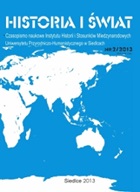Zanim powstały politechniki. Nauczanie przedmiotów matematyczno-przyrodniczych i technicznych w dobie reform Komisji Edukacji Narodowej
Before the Universities of Technology were established. The teaching of mathematics, natural sciences, and technical subjects in the period of the reforms of the Commission of National Education
Author(s): Józef PIŁATOWICZSubject(s): Higher Education , State/Government and Education, 19th Century
Published by: Instytut Historii UwS
Summary/Abstract: The Commission of National Education (Komisja Edukacji Narodowej), which was established in 1773, introduced fundamental changes relating to organisation and the curriculum in the Polish education system. The Commission constituted a kind of Ministry of Education, which exercised supervision over all the schools in the Crown and the Grand Duchy of Lithuania. The hierarchy was as follows - the Main Crown Schools in Kraków and Grand Duchy of Lithuania in Vilnius, subordinate to the Commission, were in turn superior to divisional schools, including subdivisional schools, and these in turn were superior to parish schools. The changes in the curriculum in the Main Schools were focused predominantly on broadening knowledge in the field of mathematics, natural sciences, and technical skills, which was brought to life in the form of Collegium Physicum and its respective departments, e.g. the departments of architecture, mechanics, and hydraulics, and their respective offices, gathering tools, equipment, and models facilitating the sharing of knowledge through presentations. Similar curricular changes were implemented in secondary schools. It was the first time that natural sciences with technical elements had been introduced on such a wide scale to the curriculum. The official instructions enabled the standardisation of the curriculum in all schools. The characteristic feature of the curriculum was its utilitarianism, as, when teaching each subject, particular attention was paid to developing students' skills in using acquired theoretical knowledge in practice. The changes were introduced in a systematic manner. The first step covered the preparation of the curriculum and instructions concerning its implementation, which was followed by teacher training. This was of paramount significance to the teaching of mathematics, natural sciences, and technical subjects. The class books were arranged by putting them out to tender, and often the works by foreign authors were used. The new curriculum modernised education, broadening students' knowledge of mathematics, natural sciences, and technical subjects, and preparing them for the huge civilisational changes brought by the 19th century. It aroused interest in technology, which was entering nearly all spheres of socio-economic life on a bigger and bigger scale. It proved useful in the 19th century, when Polish students went to technical colleges abroad in great numbers due to the lack of technical universities in the Kingdom of Poland and the Prussian Partition.
Journal: Historia i Świat
- Issue Year: 2013
- Issue No: 2
- Page Range: 77-113
- Page Count: 37
- Language: Polish

